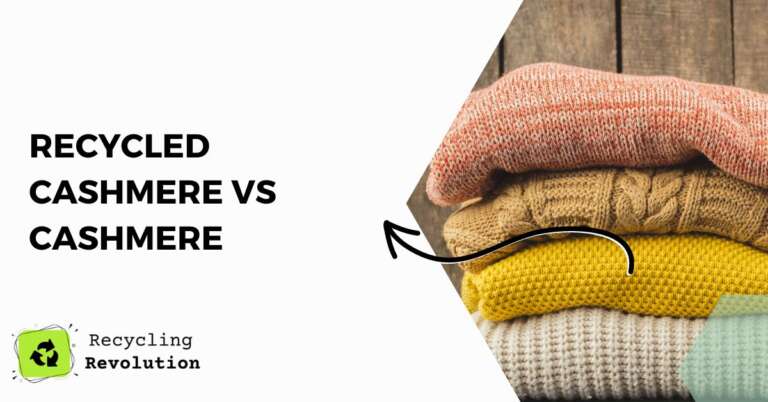Cashmere is synonymous with luxury. Derived from the soft undercoat of cashmere goats, this material is known for its unparalleled softness, warmth, and durability. Virgin cashmere is characterized by its fineness, and the longer the fibers, the better the quality.
However, sourcing and manufacturing virgin cashmere is a resource-intensive process. It can take up to four years for a single goat to produce enough undercoat to make just one sweater! Furthermore, the increasing demand for cashmere has led to overgrazing, which can negatively impact the environment.
TL;DR: When you’re looking for an ecologically responsible yet cozy fabric, recycled cashmere and virgin cashmere can both be great options. Recycled cashmere is the green choice, made from pre-loved garments that are given a new lease on life, while virgin cashmere is the premium option, sourced directly from the soft undercoat of cashmere goats.
The Emergence of Recycled Cashmere
In a bid to reduce the environmental footprint of the cashmere industry, the concept of recycled cashmere was introduced. Recycled cashmere involves collecting old cashmere garments, deconstructing them, and re-spinning the fibers into new yarn.
This process consumes significantly less water and energy compared to producing virgin cashmere. I recommend choosing recycled cashmere if you’re seeking an environmentally friendly alternative without compromising on the warmth and softness associated with cashmere.
Recycled Cashmere Vs. Cashmere: A Comparative Analysis
Quality and Comfort
- Virgin Cashmere: The quality of virgin cashmere is generally superior, thanks to the long, fine fibers. It’s softer, warmer, and more durable.
- Recycled Cashmere: While still soft and warm, recycled cashmere may not match the supreme quality of virgin cashmere. This is because recycling processes could lead to shorter fibers and possibly a less smooth finish.
Environmental Impact
- Virgin Cashmere: The production of virgin cashmere can have a significant environmental impact due to the overgrazing of land and the energy-intensive process of harvesting and processing the fibers.
- Recycled Cashmere: This eco-friendly alternative reduces the environmental impact by repurposing existing cashmere fibers, thus saving water, energy, and preventing waste.
Cost
- Virgin Cashmere: Due to its superior quality and the resources required to produce it, virgin cashmere tends to be more expensive.
- Recycled Cashmere: Given that recycled cashmere utilizes pre-existing materials, it is often less expensive than its virgin counterpart, making it a more affordable option.
The Rise of Sustainable Fashion
As a direct response to the issues faced by the fashion industry, including the overconsumption of resources and waste generation, sustainable fashion has emerged. The industry focuses on creating environmentally friendly materials, of which recycled cashmere is a part.
Brands like Patagonia and Eileen Fisher have been at the forefront of this movement, offering recycled cashmere products that are stylish, cozy, and have a reduced environmental footprint.
Ethical Considerations in Cashmere Production
While we’ve covered the environmental implications and the cost factors associated with virgin and recycled cashmere, it’s equally important to discuss the ethical considerations in cashmere production.
Virgin Cashmere: Ethical Challenges
The primary source of virgin cashmere, the cashmere goat, is native to cold climates, especially Mongolia and China. These goats produce a thick undercoat to survive harsh winters, which is then combed or sheared for cashmere production.
However, the mass demand for cashmere has led to an increase in the goat population, often resulting in overgrazing and land degradation. This not only disrupts the local ecosystem but also threatens the livelihoods of nomadic herders who rely on the land for their goats.
Moreover, animal welfare is another significant concern. While combing is a harmless process, the shearing process can often lead to cuts and injuries if not performed carefully.
Recycled Cashmere: An Ethical Alternative
Recycled cashmere provides a solution to these ethical challenges. By reusing existing cashmere garments, the need for new cashmere is reduced. This helps curb overgrazing and promotes better land management.
In addition, recycled cashmere eliminates the need for additional goat hair, alleviating concerns about animal welfare associated with virgin cashmere production.
I recommend recycled cashmere as the more ethical choice. By opting for recycled cashmere, you’re not only making an environmentally-friendly choice, but you’re also advocating for animal welfare and responsible land management.
The Recycling Process of Cashmere
Understanding the process of cashmere recycling can help emphasize why it’s a greener and more ethical choice.
- Collection: Pre-loved cashmere garments are collected from various sources. This could include donation centers, thrift stores, and even directly from consumers.
- Sorting and Grading: The collected items are sorted based on color and quality. This is a crucial step as it determines the final color of the recycled yarn.
- Deconstructing: The garments are then mechanically broken down into their constituent fibers.
- Spinning: These fibers are mixed with virgin fibers, if needed, and then spun into new yarn.
- Garment Creation: The new yarn is then used to create fresh garments, ready to be loved all over again.
The Aesthetics and Styles of Recycled Cashmere
Recycled cashmere products often retain a natural color palette, derived from the original garments. This results in less use of dyes, contributing to the eco-friendly nature of the process. The colors are generally soft and muted, adding to the appeal of these sustainable garments.
Styles in recycled cashmere have evolved significantly with the growing popularity of sustainable fashion. From classic sweaters and cardigans to trendy scarves and beanies, there’s a wide array of choices available in recycled cashmere.
Note: The availability of styles and colors in recycled cashmere might be limited compared to virgin cashmere due to the dependence on existing garments for fiber sourcing.
Sourcing Recycled Cashmere Products
When buying recycled cashmere, it’s vital to choose reputable brands that ensure quality and transparency in their recycling processes. Some brands offer certifications such as Global Recycle Standard (GRS) which confirm the traceability and integrity of the recycled material.
Furthermore, recycled cashmere should feel almost as soft as virgin cashmere. If it doesn’t, the product might have been mixed with other lesser-quality fibers. Always check the product description for fiber content.
I recommend opting for brands that value transparency and offer detailed information about their products and manufacturing processes. Remember, purchasing recycled cashmere isn’t just about getting a cozy garment—it’s about supporting sustainable practices and making a positive environmental impact.
Personal Insights and Recommendations
If you’re looking for a premium experience, there’s nothing quite like the feeling of slipping into a garment made from virgin cashmere. However, the environmental implications and higher price point may not suit everyone.
On the other hand, if you’re concerned about your carbon footprint, I recommend opting for recycled cashmere. Not only will you enjoy the comfort and warmth of cashmere, but you will also be contributing to a more sustainable world. Plus, the lower price point means cashmere luxury becomes more accessible.
Note: When purchasing recycled cashmere, make sure it is from a reputable brand that certifies its recycling processes.
Conclusion
In the battle of recycled cashmere versus cashmere, both have their merits. It boils down to personal preference, budget, and environmental consciousness.
While virgin cashmere offers a touch more luxury, recycled cashmere provides a more sustainable and affordable alternative. By understanding the differences and implications of both types, you can make an informed decision that aligns with your personal values and needs.
FAQ
Does recycled cashmere feel different from virgin cashmere?
Recycled cashmere is still soft and warm, though it may not feel as smooth as virgin cashmere due to shorter fiber lengths.
Is recycled cashmere durable?
Yes, recycled cashmere still retains the durability characteristic of cashmere, although it may be slightly less durable than virgin cashmere.
How can I care for my recycled cashmere products?
Caring for recycled cashmere is similar to caring for virgin cashmere. Hand wash in cold water with a gentle detergent and lay flat to dry. Avoid hanging as it can distort the shape of the garment.
Are there any reliable brands that offer recycled cashmere products?
Yes, brands like Patagonia and Eileen Fisher are known for their quality recycled cashmere products. Always ensure to buy from certified and reputable brands.

